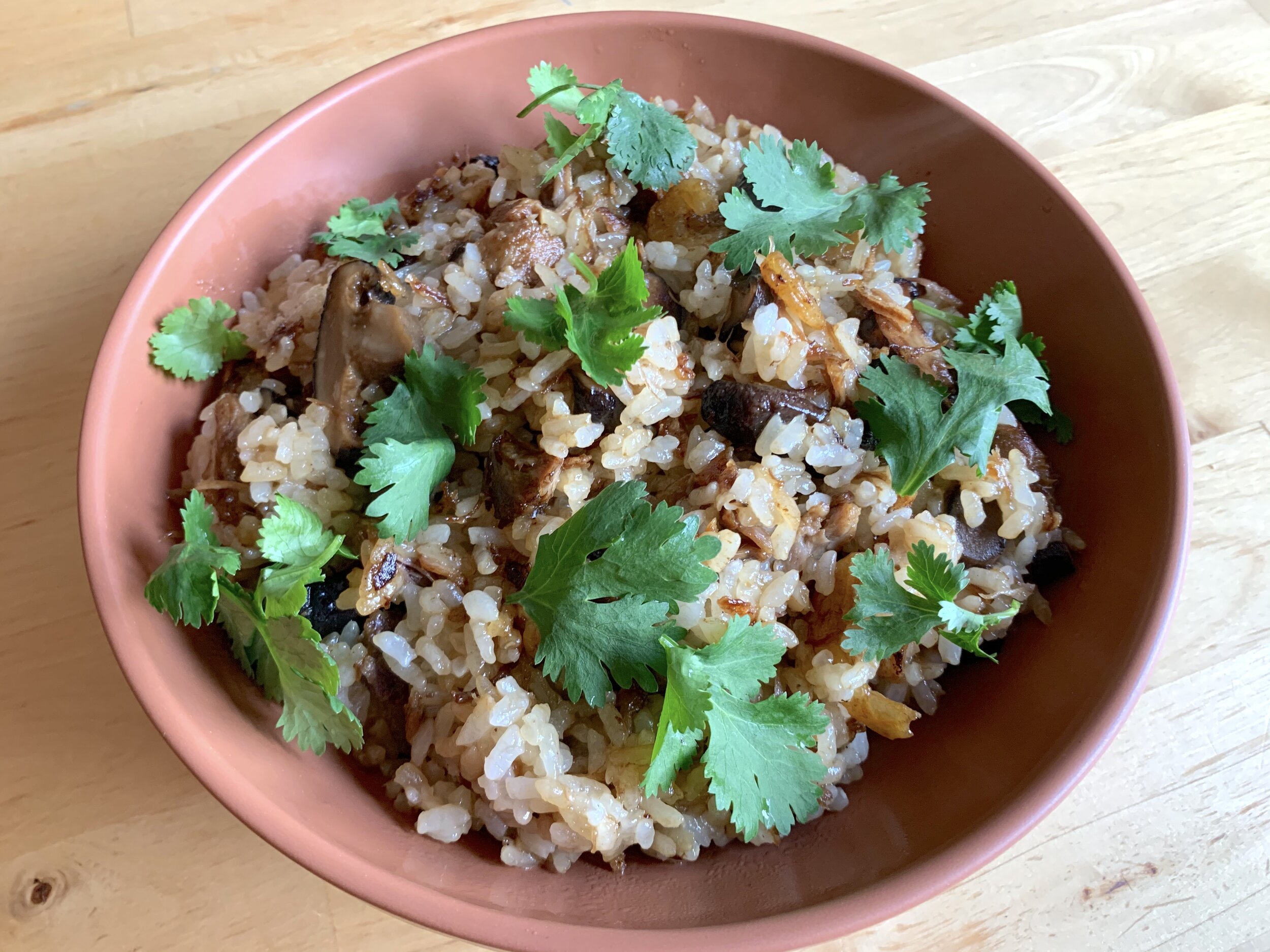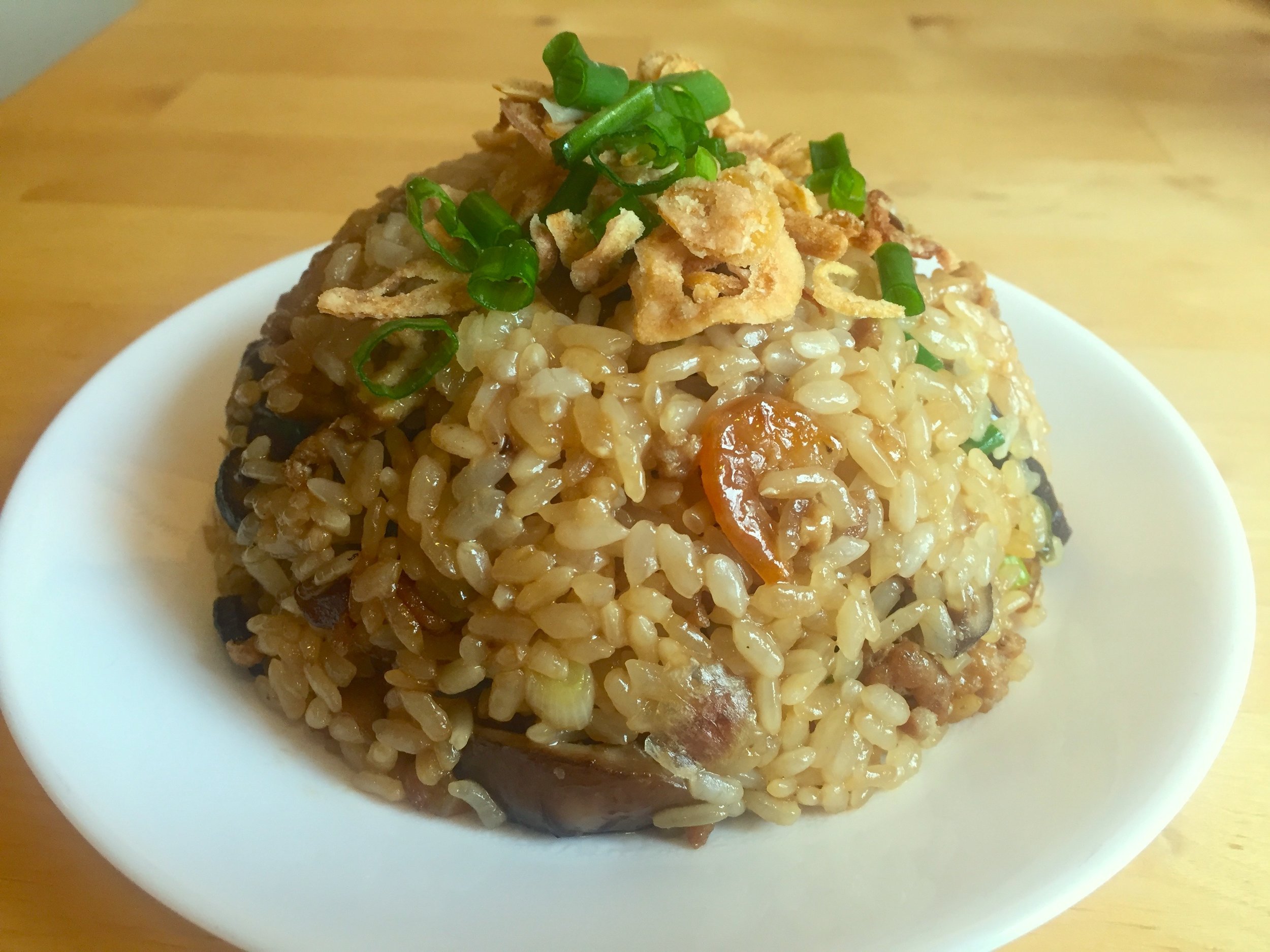Taiwanese Sticky Rice

油飯 (You Fan)
You fan (油飯) is the quintessential Taiwanese comfort food: a rich and savory sticky rice dish made with pork, mushrooms, dried shrimp, and fried shallots, and with a generous topping of fresh herbs.[1] You will often find a big bowl of this sticky rice served on festive occasions. Sticky rice is very straightforward to make—it is essentially a fried rice procedure, except with sticky rice instead of standard white rice. Here’s how to do it!
Ingredients
2 cups sticky rice
6 shiitake mushrooms, sliced
1 cup cooked pork, shredded
¼ cup dried shrimp
¼ cup fried shallots
2 tbsp soy sauce
1 tbsp dark soy sauce
1 tbsp sesame oil
1 bunch cilantro
Vegetable oil
Sticky rice, also known as sweet rice (though it does not taste sweet) and glutinous rice (though it is gluten free), is a common form of rice found on East and Southeast Asian tables. In Thailand and Laos in particular, where the rice has been grown for thousands of years, sticky rice is the staple form of rice consumed.
Sticky rice differs from other varieties of rice in that its starch consists almost entirely of amylopectin, with very little amylose.[2] Because amylopectin is more water soluble, sticky rice releases much more starch into its environment when cooked, thickening the water as a roux of cornstarch slurry would and creating a sticky, chewy texture. Most sticky rice found in supermarkets have been milled. However, you can sometimes find unmilled sticky rice with an intact coat of bran, which will appear purple or black (the sticky rice equivalent of standard brown rice). Sticky rice also exists in both long-grain and short-grain forms. For this recipe, we will be using two cups of milled, short-grain sticky rice.
A rice cooker is the easiest way to cook sticky rice—combine two cups of sticky rice with three cups of water and cook according to the manufacturer’s instructions. If your rice cooker has a dedicated sticky rice setting, use it! If your rice cooker doesn’t have a sticky rice setting, though, you are better off steaming the rice or cooking it on the stovetop. Soak the rice in cold water for about an hour before starting to cook it. After the soak, proceed as you would when cooking other type of rice. Be aware that sticky rice burns more readily than normal white rice. Also, be aware that because of the amount of starch released by sticky rice grains, draining excess water at any point in the cooking process is not an option. If you start with too much water, you will end up a gluey, unsalvageable mess. Regardless of your rice cooking method, it is better to err on the side of less water than more water, adding water gradually if the rice needs it.
While our rice is cooking, let us prepare our other ingredients. Soak the dried shrimp in cold water for 5-10 minutes before using them, to rinse off excess salt. Slice the shiitake mushrooms and set aside. This recipe also calls for 1 cup of cooked pork—the best cuts to use for this dish are slow-cooked shoulder or pork belly. I often use pork which has been simmered as part of a soup (the pork ribs from pork and daikon soup work well too). If you are cooking some pork shoulder bespoke for this dish, bring a pot of water to a boil with some sliced ginger, garlic, and one star anise pod. Place the pork in the pot and simmer for 2-3 hours, or until the pork is falling-apart-tender. Let cool, then shred for use in this recipe.
Heat about 1 tablespoon vegetable oil (or pork or duck fat) in a pan over medium heat. When the oil is up to temperature, add the shallots and dried shrimp to the pan and fry until fragrant, for about 1 minute. Then add the cooked pork and mushrooms to the pan and fry for 5 minutes, until the mushrooms are cooked through and the pork has begun to crisp up. At this point, if the rice is still cooking, we can turn the heat off the pan and wait for the rice before we proceed to the next step.
Add the rice to the pan, break it up with a spatula, and add both soy sauces. The light soy sauce is providing most of the flavor here, with the dark soy sauce providing the color. Stir over low heat until the rice and other ingredients are well mixed, and the color of the rice is uniform, approximately 2-3 minutes. Turn off the heat, and add 1 tablespoon toasted sesame oil. Stir the oil into the rice, then remove to your serving bowl. Top with fresh cilantro leaves and serve.
Substitutions
You can find fried shallots in most Asian supermarkets. If you don’t have any on hand, thinly slice some fresh shallots, and fry them in the oil before adding the dried shrimp. You can use leftover Taiwanese braised pork or Taiwanese minced pork as the cooked pork in this recipe. If you do so, however, reduce the amount of soy sauce you add to the rice, as both of these recipes are already seasoned. You can also add some salted egg yolks to the finished rice, for extra richness.
If you don’t have (or don’t like) cilantro, you can substitute scallions or green garlic. Some sort of herb is necessary though, to cut through all of the richness. If you have some rendered pork or duck fat, use it instead of vegetable oil when you are frying the ingredients!
[1] In Mandarin, “you fan” translates to “oil rice.”
[2] It has been determined that the abnormally high amylopectin content of sticky rice is the result of a single point mutation which was then selected for by early farmers. Olsen et al., Molecular Evidence on the Origin of Glutinous Rice, Genetics, 2002.
Recipe
Prep Time: 10 min Cook Time: 40 min Total Time: 50 min
Difficulty: 2/5
Heat Sources: 1 burner
Equipment: rice cooker (optional), pan
Servings: 6
Ingredients
2 cups sticky rice
6 shiitake mushrooms, sliced
1 cup cooked pork, shredded
¼ cup dried shrimp
¼ cup fried shallots
2 tbsp soy sauce
1 tbsp dark soy sauce
1 tbsp sesame oil
1 bunch cilantro
Vegetable oil
Instructions
1. In a rice cooker or in a pot on the stove, cook the sticky rice with three cups of water.
2. Heat 1 tbsp vegetable oil in a pan over medium heat. Add the shallots and dried shrimp to the pan and fry for about 1 minute, until fragrant.
3. Add the cooked pork and mushrooms to the pan and fry for 5 minutes, stirring occasionally, until the mushrooms are cooked through and the pork has begun to crisp up.
4. Add the cooked sticky rice to the pan, breaking it up with a spatula. Follow immediately with both soy sauces. Turn the heat down to low and cook, stirring continuously, until the ingredients are well integrated and the sticky rice is uniform in color, about 2-3 minutes.
5. Turn off the heat, and stir the sesame oil into the rice.
6. Remove the rice from the pan, top with cilantro leaves, and serve.












